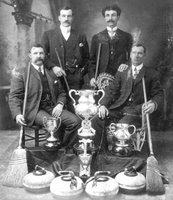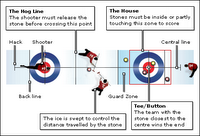 Curling is a sport with probable origins in Scotland. The first known curling stone was dated 1511 on the stone itself. Written accounts of curling occur in 1541 from Paisley Abbey, Renfrew. Curling was also depicted in two painting by Pieter Brueghel the Elder in 1565 showing Dutch peasants playing the game.
Curling is a sport with probable origins in Scotland. The first known curling stone was dated 1511 on the stone itself. Written accounts of curling occur in 1541 from Paisley Abbey, Renfrew. Curling was also depicted in two painting by Pieter Brueghel the Elder in 1565 showing Dutch peasants playing the game.No matter what, it's clear that this unusual sport has very old origins. Curling is played in a way that is similar to lawn bowling There are two targets (known as the house) on an ice rink with the center of the target known as the button or tee. Each team of 4 players is led by a captain (or skip). Curlers slide the stone down the ice trying to get as close as possible to the button. The slider's teammates use brooms to sweep the ice in front of the stone so that it can slide even further.
An inning (or end) is over after all 8 players (4 on each team) have taken their turns. A team scores one point for each stone that is nearer to the tee than any of the other team's stones. Only one team can score in each inning. If there are no stones in the house, or if the closest stones from the opposing teams are the same distance from the tee, there is no scoring for that inning.
Strategy involves trying to knock out opposing team's stones from the house so that they will be unable to score. It is also important to try not to knock out the stones of fellow teammates.
The stones are made of polished granite and have a maximum diameter of 36 inches and a maximum weight of 44 pounds.
The name "curling" comes from the ability of many curlers to put a spin on the stone, curling it around other stones. In this way, a team with good curlers can "spin" their stones into place, getting more inside the house and closer to the button for that end.

Sources: HickokSports.com, Wikipedia

No comments:
Post a Comment